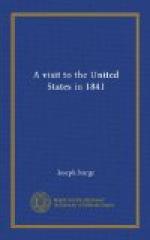driver remonstrated with him so effectually, that he
wept like a child, and promised forgiveness to
his slave.
“Having a great desire to see the imported cattle on Henry Clay’s plantation, I went thither. On approaching the house I saw a colored man, to whom I said, ‘Where wert thou raised?’ ’In Washington.’ ‘Did Henry Clay buy thee there?’ ’Wilt thou shew me his improved cattle?’ He pointed to the orchard, and said the man who had charge of them was there. As I followed his direction, I encountered a very intelligent-looking boy, apparently eight or nine years old. I said to him, ’Canst thou read?’ ‘No.’ ’Is there a school for colored people on Henry Clay’s plantation?’ ‘No.’ ‘How old art thou?’ ‘Don’t know.’ In the orchard I found a woman at work with her needle. I asked ‘How old art thou?’ ‘A big fifty.’ ‘How old is that?’ ’Near sixty.’ ‘How many children hast thou?’ ‘Fifteen or sixteen.’ ‘Where are they?’ ’Colored folks don’t know where their children is; they are sent all over the country.’ ’Where wert thou raised?’ ‘Washington.’ ‘Did Henry Clay buy thee there?’ ‘Yes.’ ‘How many children hadst thou then?’ ‘Four.’ ‘Where are they?’ ‘I don’t know. They tell me they are dead.’ The hut, in which this ‘source of wealth’ lives, was neither as good, nor as well floored as my stable. Several slaves were picking fruit in the orchard. I asked one of the young men whether they were taught to read on this plantation, and he answered, ‘No.’ I found the overseer of the cattle with a short handled stout whip, which had been broken. He said it answered both for a riding whip, and occasionally ‘to whip off the slaves.’
“What, my friend, is to be learned from these gleanings at Ashland?—from the doings of our mutual friend, Joseph John Gurney’s ‘dear friend,’ Henry Clay: the man who boasts that ‘every pulsation of his heart beats high for liberty,’ yet is not ashamed to buy men and women at the Capitol!—that place which, above all others, ought not to be cursed by the footsteps of a slave. Yet I fear there are not wanting in the abolition ranks men so wedded to political party, that they may be tempted to vote for Henry Clay; serving their party and themselves thereby, and perchance thinking they serve their country.
“Do not think Clay a sinner above all other men. His slaves appeared to be well fed and well clothed. Indeed, the general superiority of condition in Kentucky slaves, over those of Maryland and Virginia, cannot fail to strike the most superficial observer.
“Pursuing my journey, I came to Blue Lick, whose waters are celebrated throughout the United States. At the spring I found several men, white and colored. I asked if I could have a drink. A white man said the waters were free to all. I asked, ’Will they make all free?’ They again replied that the spring was free to all. ‘I perceive thou dost not understand my question,’ said I. But




